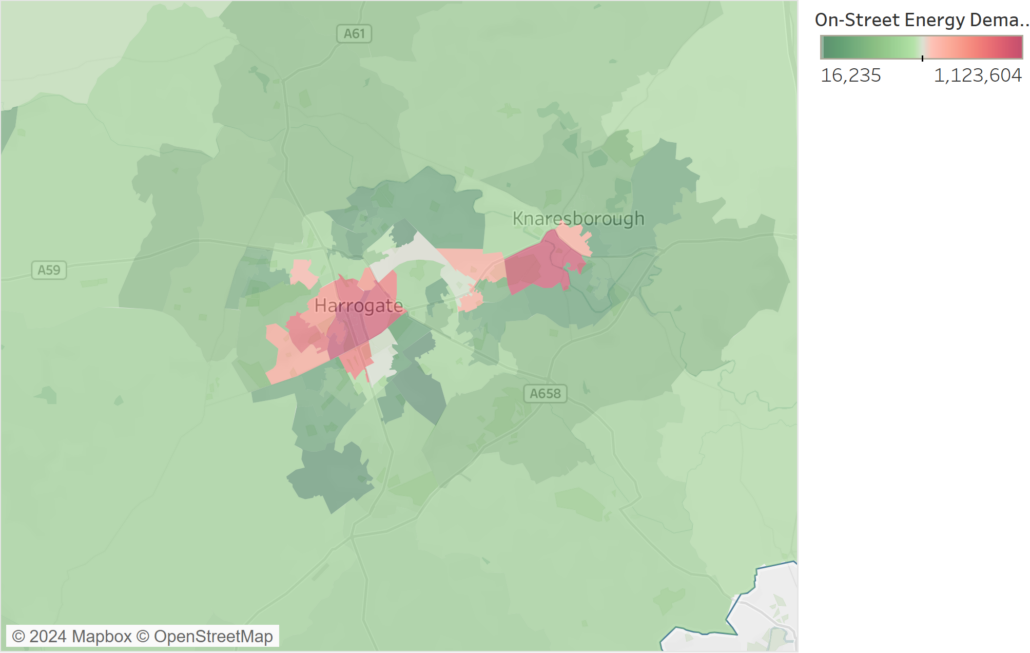Harrogate will need over 13 times more EV chargers by 2035: How many more will your local authority need?
As the adoption of electric vehicles (EVs) continues to rise, the pressure on local EV charging infrastructure intensifies. The critical question is how many additional chargers will be needed to meet this surge in demand ?
Field Dynamics has revolutionised the approach to identify the right amount of EV chargers with GigaMap, a dataset that combines 140 million MOT records and EV efficiency data to calculate kilowatt-hour (kWh) power demand for cars and vans at a hyper-local level. This data-driven methodology transforms our understanding of power and charging infrastructure by providing real-world insights.
Utilising GigaMap‘s Local Super Output Area (LSOA) level data, local authorities can gain a granular view of power demand, allowing them to pinpoint the number of chargers required and strategically deploy them in specific neighbourhoods.
Using Harrogate as an example scenario, assuming EV efficiency, charger utilisation, and vehicle usage remains the same as today, we projected the public charging demand for 2035.
What will the car and van public charging demand be in Harrogate in 2035?
If all cars and vans went electric overnight, Harrogate would need 205 GWh annually to support the fleet and, as GigaMap breaks down demand by on-street/off-street households, 48 GWh of that is specifically required for on-street households.
Focusing on 2035, Future Energy Scenarios Consumer Transformation pathway (EC.11) projects 80% of vehicles will be electric so, if we use these figures for our scenario, public charging demand becomes 38 GWh.
What is the current public charger output in Harrogate?
Examining the current public charger output in Harrogate, with 177 chargers (according to the National ChargePoint Registry), a 15% average time utilisation rate (the average according to ZapMap), and average charger throughputs (as identified in REA’s Charging Forward to 2030 Report) we can see the indicative power output for different charger types as follows.
| Charger Type | Number of public chargers | Yearly potential output at 15% utilisation |
| Slow | 127 | 0.5 GWh |
| Fast | 6 | 0.06 GWh |
| Rapid | 29 | 1.33 GWh |
| Ultra Rapid | 15 | 0.99 GWh |
Calculating the total charging energy potential at 15% charger time utilisation revealed a significant gap between the current output and future demand.
How many more chargers could Harrogate need in 2035?
In 2035, with a projected demand of 38 GWh and a current output of just under 3 GWh, Harrogate faces a gap of 35 GWh. Meeting this modelled demand would necessitate over a 13x increase in EV charging energy. If we proportionately increase today’s charger numbers in Harrogate we would need:
| Types of chargers | Number of public chargers |
| Slow | 1698 |
| Fast | 80 |
| Rapid | 388 |
| Ultra Rapid | 201 |
Where should EV chargers be placed in Harrogate?
GigaMap proves instrumental not only in understanding the gap but also in strategically deploying the required chargers to meet the growing demand in Harrogate.
By leveraging LSOA-level data, local authorities can precisely assess charging needs at the neighbourhood level with both EV charging requirements as well as on-street parking ratios. This allows councils to identify and prioritise high-demand locations for an efficient rollout of EV charging infrastructure.
Knowing these high demand areas means local authorities optimises resource allocation and enhances the overall effectiveness of the charging network, aligning it closely with the specific demands of each neighbourhood within Harrogate.
The image shows the neighbourhoods in Harrogate with the most charging demand.
Conclusion
In conclusion, while scenarios are not absolute truths, this data-driven assessment of power demand provides a reasonable framework to comprehend the magnitude of the challenges ahead at a local level.
GigaMap equips local authorities with a valuable tool to understand and prepare for the evolving landscape of EV charging demands by providing concrete data and actual usage patterns, allowing decision-makers to make informed choices. Ensuring that charging infrastructure keeps pace with the accelerating adoption of electric vehicles, that uncertainties are minimised, and optimising resource allocation.






